
Environmental activist Jerry Cope has spent the last few weeks traveling along the Gulf Coast and experiencing firsthand the contamination in the air and water. In an article being published on Huffington Post, Cope argues that instead of celebrating the allegedly vanishing oil, we should be concerned about the disappearance of marine life in the Gulf. He describes the Gulf as a “kill zone” and looks into where the marine animals have gone, given that BP has reported a relatively low number of dead animals from the spill. [includes rush transcript]
Transcript
AMY GOODMAN: BP has announced its latest attempt to seal the largest oil spill in US history once and for all appears to be working. Dubbed “static kill,” the operation forces a heavy, synthetic fluid called drilling mud down into the well. BP said today pressure in the well appears to be stabilizing.
A seventy-five-ton cap placed on the well last month has contained the oil, but it’s considered a temporary measure. According to government estimates, nearly five million barrels of oil gushed into the Gulf of Mexico from BP’s oil well before it was capped July 15th. Scientists estimate as many as 62,000 barrels of oil were leaking from the well each day at its peak. That’s more than twelve times as much oil as the government originally projected.
Retired Coast Guard Admiral Thad Allen, who’s coordinating the Obama administration’s response to the oil spill disaster, said static kill alone is not enough to plug the well.
THAD ALLEN: The relief wells are the answer. There’s a limit to how much we know and can find out from the static kill, if you will. First of all, if annulus cannot be accessed from the top — in other words, we didn’t compromise the seals — then we’ll only be able to fill the drill pipe itself, the casing, with mud, and then we’d have to actually go to the bottom anyway. We need to go into the bottom to make sure we fill the annulus, the casing and any drill pipe there, then follow that with cement. This thing won’t truly be sealed until those relief wells are done.
AMY GOODMAN: Well, ever since BP placed a temporary cap on the well last month, the media has been abuzz with reports of how the oil has largely disappeared from the surface of the Gulf of Mexico. And the New York Times
is reporting today the government is expected to announce today that three-quarters of the oil has already evaporated, dispersed, been captured or otherwise eliminated, and that much of the rest is so diluted it doesn’t seem to pose much additional risk of harm. It’s not clear what effect the more than 1.8 million gallons of the dispersant Corexit that was dumped in the Gulf will have.
But independent journalists, scientists, activists and fisherfolk who have been to the Gulf recently tell a different story. I’m joined now by two guests. From Washington, DC, Antonia Juhasz is with us, director of the Chevron Program at Global Exchange and author of The Tyranny of Oil: The World’s Most Powerful Industry — and What We Must Do to Stop It. She’s just back from Louisiana, where she found some of BP’s “missing oil” — on the wetlands and beaches along the waterways near St. Mary’s Parish, where no one is booming, cleaning, skimming or watching.
And joining us from New Orleans is environmentalist Jerry Cope. He has spent the last few weeks traveling along the Gulf Coast and experiencing firsthand the contamination in the air and water. He just published a piece in the Huffington Post where Cope argues that instead of celebrating the allegedly vanishing oil, we should be concerned about the disappearance of marine life in the Gulf. He describes the Gulf as a “kill zone” and looks into where the marine animals have gone, given that BP has reported a relatively low number of dead animals from the spill.
We welcome you both to Democracy Now! Jerry Cope, let’s begin with you in New Orleans. Talk about what you found.
JERRY COPE: Well, a friend of mine, Charles Hambleton, and I came down about three weeks ago. We’ve been hearing a lot of stories. People were calling both of us regarding the loss of marine life and that there was a tremendous cover-up operation in place to conceal this from the public and the media. And this was at the same time where a lot of, you know, mainstream media were complaining about restricted access, that they couldn’t get onto the beaches, they weren’t allowed to fly. So these calls kept coming in.
We finally decided three weeks ago to come down and see for ourselves what the situation was, and we went from Louisiana all the way to Florida, spent a great deal of time around Orange Beach and Gulf Shores, Alabama, which tends — is kind of like ground zero in this whole mess, in terms of especially the effects of the dispersant. There’s a great many people there that are sick and ill. The doctors aren’t really sure how to treat them. Dr. Riki Ott’s been down, spending a lot of time with those folks. Myself, I have a pneumonia induced by chemical exposure. I’ve been talking to doctors in Boston.
But the — we talked to numerous fishermen and local people, and there was, in fact, a very large-scale operation with BP, assisted by several federal agencies, to cover up the loss of marine life. They gathered up the fish, birds, whales, dolphins, all the sea life, and the carcasses were destroyed, in very large numbers.
AMY GOODMAN: Jerry Cope, you mentioned Riki Ott. You interviewed the marine toxicologist — she’s an Exxon Valdez survivor — last week about the disappearance of marine life in the Gulf. This is a clip from that interview.
RIKI OTT: We also know from Exxon Valdez that only one percent, in our case, of the carcasses that floated off to sea actually made landfall in the Gulf of Alaska. I don’t believe there’s been any carcass drift studies down here that would give us some indication of when something does wash up on the beach, what percentage is it of the whole. But anyway, we know that offshore there was an attempt by BP and the government to keep the animals from coming onshore in great numbers. And the excuse was, this is a health problem, we don’t want to create a health hazard. And that will only be a good excuse if they kept tallies of all the numbers that died, because all the numbers, all the animals, are evidence for federal court. We, the people, own these animals, and they become evidence for damages to charge for BP. In Exxon Valdez, the carcasses were kept under triple lock-and-key security until the Natural Resource Damage Assessment study was completed. And that was in about a year and a half — two-and-a-half years after the spill. And then, all the animals were burned, but not until then.
AMY GOODMAN: That was Riki Ott. She’s an Exxon Valdez survivor. She’s a marine biologist. Jerry Cope, take it from there. What happened, do you believe, to the animals in the Gulf, to the marine life?
JERRY COPE: Well, there were two dramatic sequences that were described by workers that were out at the source, which is what they called the Canyon 252 site where this incident occurred. And they reported seeing, just as far as the eye could see, dead carcasses of all kinds of marine life out near the source. And then there was also — we heard numerous accounts of a large wave of marine life being pushed into shore as the dispersant and the oil, the first wave, came in and approached towards the end of June. And then, all of a sudden, it was simply gone. All of these animals disappeared. They didn’t show up in the lagoons in any large numbers. And everyone — all the scientists were questioning, where did they go?
I spoke to Hal Whitehead, who studied extensively sperm whales, specifically, the ones down in the Gulf of Mexico, and there was an unusual pod that was resident in the area of the Mississippi Canyon site, and they’ve also disappeared, the entire pod. And that was an unusual social structure there in that those particular sperm whales were not terribly nomadic. They seemed to stay there, as well as the usual whales that moved in and out with the population.
AMY GOODMAN: What about the Corexit, Jerry Cope, the chemical dispersant? What the government is saying — there is just tremendous elation in the media now with the government announcing that 75 percent of the oil is gone. What about the Corexit?
JERRY COPE: Well, last week, we spent two days flying over the Gulf. We went south from Louisiana and then all the way out, then back, all the way back up to Florida. And for as far as the eye can see, the entire Gulf of Mexico is a very strange green color. It’s not blue at all; it’s green. And it’s iridescent. You can — the dispersant, obviously, covers the entire ocean out there, well beyond the site of the spill. And there’s nothing moving. We saw, in two days of flying, four dolphins, that didn’t appear to be very happy, and then three schools of rays, as I put in the article. There’s nothing moving out in the water there.
And as far as the effects of the Corexit, the EPA came out with these wonderful reports yesterday how it’s no more toxic than the oil. But I didn’t read in any of those reports just how toxic the oil was. BP, in their training classes for hazmat, all of the crews that worked on the spill, part of that training, which was a four-hour program, is they told them, in no uncertain terms, if you had any cuts to your skin, abrasion, open wounds, and it was exposed to the crude oil in the water, on the beaches, any form whatsoever, you could pretty much guarantee yourself that you would get cancer in your lifetime. That was part of the training class. So, the oil is most definitely toxic. The Corexit is very toxic. In my opinion, it’s terrible. It evaporates and puts all of this up into the atmosphere. There’s a lot of sick people along the coast. And I called it the Jaws syndrome. It’s life imitating art on a scale that’s hard to wrap your head around, because they are pretending the situation is entirely normal.
AMY GOODMAN: Antonia Juhasz is also with us in Washington, DC, author of The Tyranny of Oil. You have just come back from the Gulf of Mexico. You’re writing a book on what’s happened there, Antonia. Can you talk about what you found in the Gulf, in St. Mary’s Parish, and where that is?
ANTONIA JUHASZ: Yeah. St. Mary’s Parish is one bayou over from Venice Beach area, which is the focus of a lot of the coverage of where the oil has been coming ashore and where a lot of the oil impact has been. So it’s one bayou over. And I went down there to attend a BP community forum that was held Thursday night. And at this forum, the parish president announced that St. Mary’s Parish doesn’t have oil, has never had oil, and won’t have oil hitting its shores. As soon as he said that, he was immediately surrounded by fishermen. And one of the fishermen said, “Well, if that’s true, then why does Kermit have oil in his bag right now?” And one of the fishermen, everyone turned to him, and he said, “You know, I was just out on the water, like I’ve been every day, looking for oil, and I saw oil, and I’ve seen oil. And we’ve been telling you that there’s oil.” At that point, the microphone was turned off, and, you know, essentially all hell broke loose. And the Coast Guard, which was there, went over to this fisherman and said, you know, “If you saw oil, show us where you saw the oil.” And they went over and they looked at maps, and he showed them where the oil was. And they were very concerned.
And then I, the next day, went out with him, and we spent five hours going along the coast of Oyster Bayou to Taylor Bayou in his boat, and what I saw was oil, waves of oil that had washed in. They had clearly washed in, because it was — you could see the wave effect. It was over the wetlands, grass, grassy areas, just coated in waves of oil that had hit. We went to beaches that were covered with tar balls. And, you know, this is not an unusual sight. Anyone who’s been watching TV has seen these sights. What was completely unusual, in my experience over three months of time going down to the Gulf, is that there was no one around. There were no cleanup workers. There was no boom. There was no evidence that anyone had any concern about this oil. And, in fact, that’s what we found out, that the Coast Guard then reported, after it went and looked at these locations, that it wasn’t enough to worry about. And that didn’t make any sense to the fishermen who I spoke to and the fisherman I was with, who said, “One, this is oil that is in and around where we live, where we fish, at the heart of our livelihood, which is this Oyster Bayou. And also, this is oil coating” — and I saw it — “the marshlands, the wetlands,” which is, you know, when the oil gets into the grass, if it stays there, it can kill the root system. If it kills the root system, it kills the wetlands. If it kills the wetlands, there’s no barrier to, one, the oil getting further in and, two, more importantly in this area, hurricane provision and hurricane protection.
And this is also completely out of whack with what BP had been doing previously, in my experience, which is, wherever you saw oil, there wasn’t far behind a BP cleanup crew that would clean it up. Of course, the oil would just wash back on, and then they’d come back and they’d clean it up again. What is astounding, from my experience, is that it is evidence of what we’re hearing and seeing all across the Gulf, which is the cleanup apparatus being pulled away and removed. And the reason to do that is just as these — the press reports are saying, if the oil is out of sight, it’s out of mind. We know it’s out of sight, primarily, one, because the well is capped — thank goodness — but two, that it’s been dispersed. It’s been dispersed, and we can’t see it. And if BP can pull up its cleanup crews and show that everything is OK, the idea is that it would significantly limit the potential liability that BP faces. If it can say about the oil-soaked areas that I saw, “Oh, that’s insignificant,” then they’re not liable for cleanup, not liable for the consequences to that community — at least, I imagine that’s what they would argue — in St. Mary’s Parish. Of course, they should be, and are, but that seems to be the logic, and it’s devastating to see it taking shape on the ground.
AMY GOODMAN: Antonia Juhasz, you’re in Washington, DC, up from the Gulf of Mexico, because the Senate is expected to take up energy spill legislation today. Quickly explain what that is.
ANTONIA JUHASZ: Well, they’re not, so — what was supposed to happen was two waves of legislation. One was the climate legislation that was supposed to happen addressing the ravages of climate change. That got pushed aside. What was initially supposed to happen was that the climate legislation that was on the table was going to now include spill response legislation, capping — or eliminating the cap on liability for oil companies involved in disasters like this, maintaining the moratorium put in place by the Obama administration, oversight and regulatory measures to the Interior Department, a lot of very good provisions that are needed to address making sure a disaster like this doesn’t happen and making sure — in the future, and making that BP actually is held liable for what it’s done. First, the climate package was pulled. It was felt there wouldn’t be votes for that. Then, just last night, where there was supposed to be a Senate spill bill that was supposed to come through today, that got pulled yesterday, because there weren’t going to be enough votes — just for that, this very small, very simple, very limited measure that would have been the only congressional response at this point, legislatively at this point.
AMY GOODMAN: And very quickly — we have fifteen seconds — BP planning to sell $30 billion in assets?
ANTONIA JUHASZ: Yeah, BP is starting a fire sale to get rid of $30 billion worth of itself to try and consolidate its operations. My concern about that is, who’s going to buy those pieces? Exxon and Chevron have said they’re in the market. They’ve actually said they’re interested in potentially buying BP. And that would be disastrous, in my mind, in terms of further concentration and wealth and political influence being put into an ever-smaller number of corporate hands. Most disconcerting, we heard that — there’s a rumor that the Obama administration may be —-
AMY GOODMAN: Five seconds.
ANTONIA JUHASZ: —- signaling a green light to such a potential change — something we want to make sure doesn’t happen.
AMY GOODMAN: Antonia Juhasz and Jerry Cope, thanks so much for joining us.


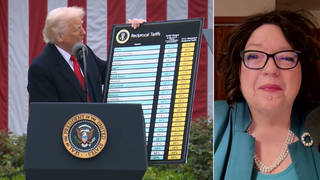
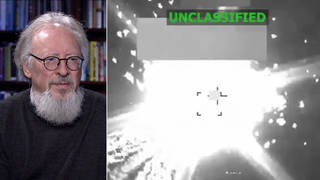
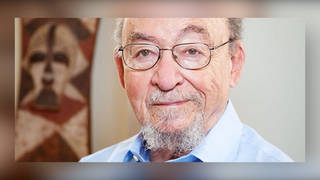





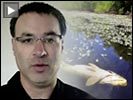
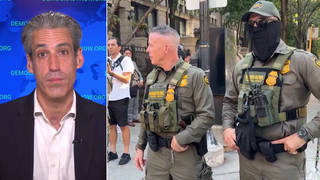
Media Options